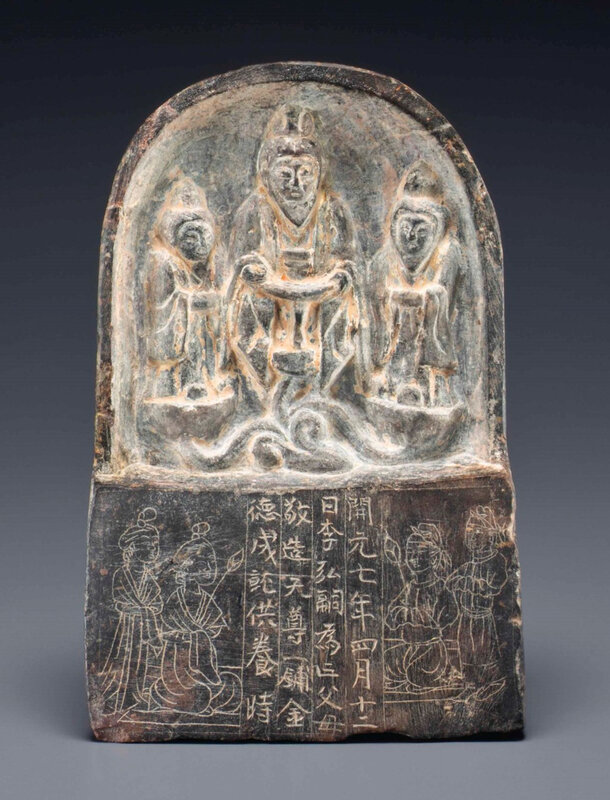A rare small dark grey stone Daoist stele, Tang dynasty, dated by inscription to AD 719
Lot 1510. A rare small dark grey stone Daoist stele, Tang dynasty, dated by inscription to AD 719; 7¾ inches (19.7 cm) high. Estimate USD 12,000 - USD 15,000. Price realised USD 47,500. © Christie's Images Ltd 2013
The front is carved with a central figure of the deified sage Laozi shown seated behind a u-shaped arm rest, flanked by acolytes standing on lotus-pod supports rising from the same stalk which also supports Laozi. The figures are carved in relief within an arched recess above a flat panel finely engraved with two female figures and two male figures flanking an inscription, which is carved in four columns of kaishu calligraphy recording the donor's name as 'Li Hongsi' and the date as Kaiyuan qi nian si yue shi er ri, which may be read as the 7th year, 4th month, 12th day of the Kaiyuan reign, corresponding to 719.
Provenance: Private collection, New York.
J.J. Lally & Co., New York, 1996.
Literature: Jin, Sheng, Zhongguo lidai jinian foxiang tudian (Illustrated Dictionary of Dated Chinese Buddhist Sculpture), Beijing, 1994, no. 281, with a short description on p. 536, recording the sculpture as being overseas, whereabouts unknown.
Hu, Wenhe, Zhongguo Daojiao shike yishu shi (History of Chinese Daoist Stone Sculpture), Beijing, 2004, pp. 191-92, pl. 51, no. 65.
Note: Laozi did not promote Daoism as a religion, and in fact the idea of religious practice with a church hierarchy, rituals and iconography is quite contrary to the original spirit of Daoism. Nevertheless, as the popularity of Daoism grew over the centuries, a religious practice and organizational structure developed. In the Tang dynasty, the emperor Gao Zong (reigned A.D. 650 - 684) canonized Laozi as Taishang yuanxuan huangdi, "Great Emperor of the First Foundations" (of Daoism), and sculptures such as this stele were produced for temples and private shrines, following the style and iconography of Buddhist sculptures.
A similar small stone stele with the same triad showing Laozi and acolytes above kneeling donor figures flanking an inscription dated A.D. 725 is in the Yamato Bunkakan Museum, Nara, Japan, published in the Illustrated Catalogue of the Museum Yamato Bunkakan Series, No. 5, 1992, p. 31, no. 32. Compare, also, the similar Daoist stele with donor figures and dedicatory inscription including a date corresponding to A.D. 741, excavated in Shanxi province in 1987, and included in a travelling exhibition in Australia, illustrated in the catalogue Imperial China: The Living Past, Sydney, 1992, p. 79, no. 55.
Christie's. Fine Chinese Ceramics and Works of Art, New York, 19 - 20 September 2013

/https%3A%2F%2Fprofilepics.canalblog.com%2Fprofilepics%2F1%2F0%2F100183.jpg)
/https%3A%2F%2Fstorage.canalblog.com%2F03%2F02%2F119589%2F96711876_o.jpg)
/https%3A%2F%2Fstorage.canalblog.com%2F11%2F31%2F119589%2F94773502_o.jpg)
/https%3A%2F%2Fstorage.canalblog.com%2F20%2F83%2F119589%2F94772815_o.jpg)
/https%3A%2F%2Fstorage.canalblog.com%2F26%2F72%2F119589%2F75604929_o.jpg)
/https%3A%2F%2Fstorage.canalblog.com%2F59%2F60%2F119589%2F26458628_o.jpg)



/http%3A%2F%2Fstorage.canalblog.com%2F75%2F49%2F119589%2F129758853_o.jpg)
/http%3A%2F%2Fstorage.canalblog.com%2F93%2F40%2F119589%2F129411239_o.jpg)
/http%3A%2F%2Fstorage.canalblog.com%2F17%2F14%2F119589%2F129411215_o.jpg)
/http%3A%2F%2Fstorage.canalblog.com%2F33%2F92%2F119589%2F129411180_o.jpg)